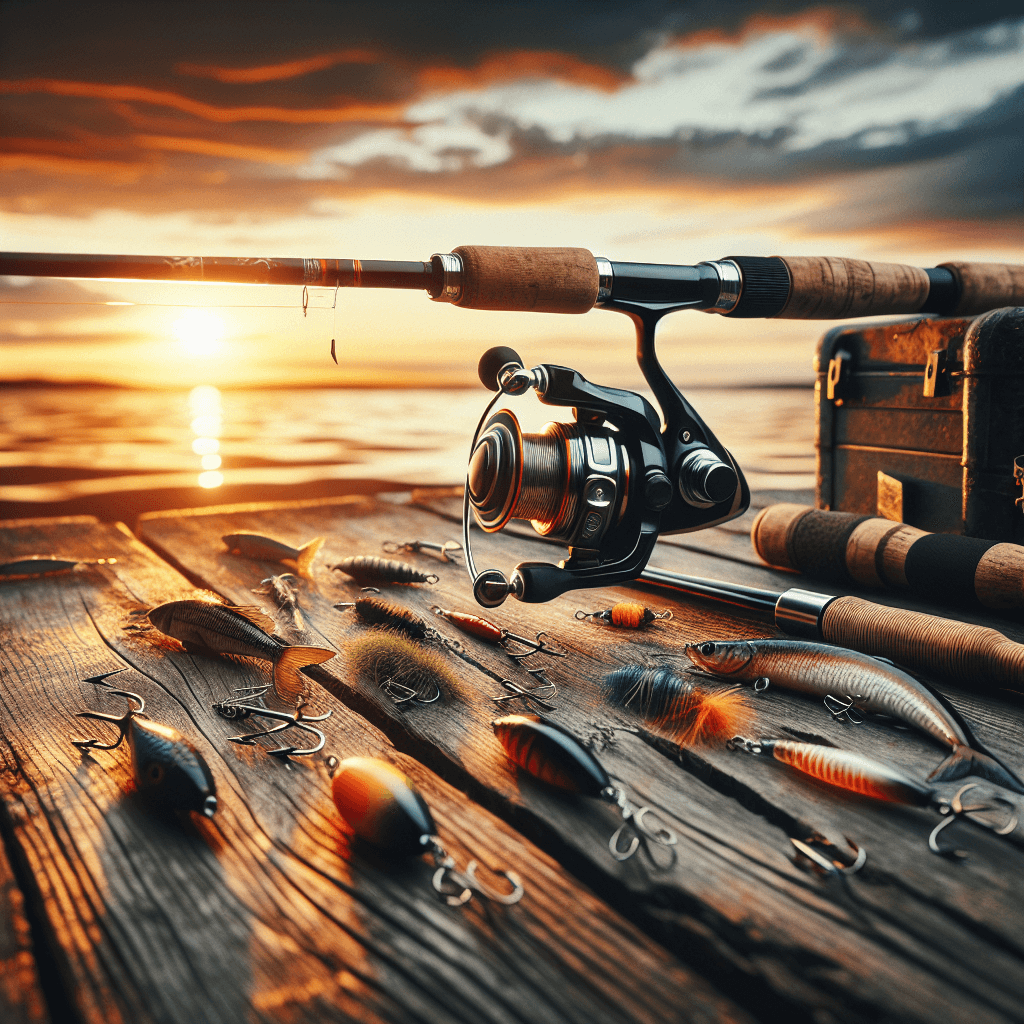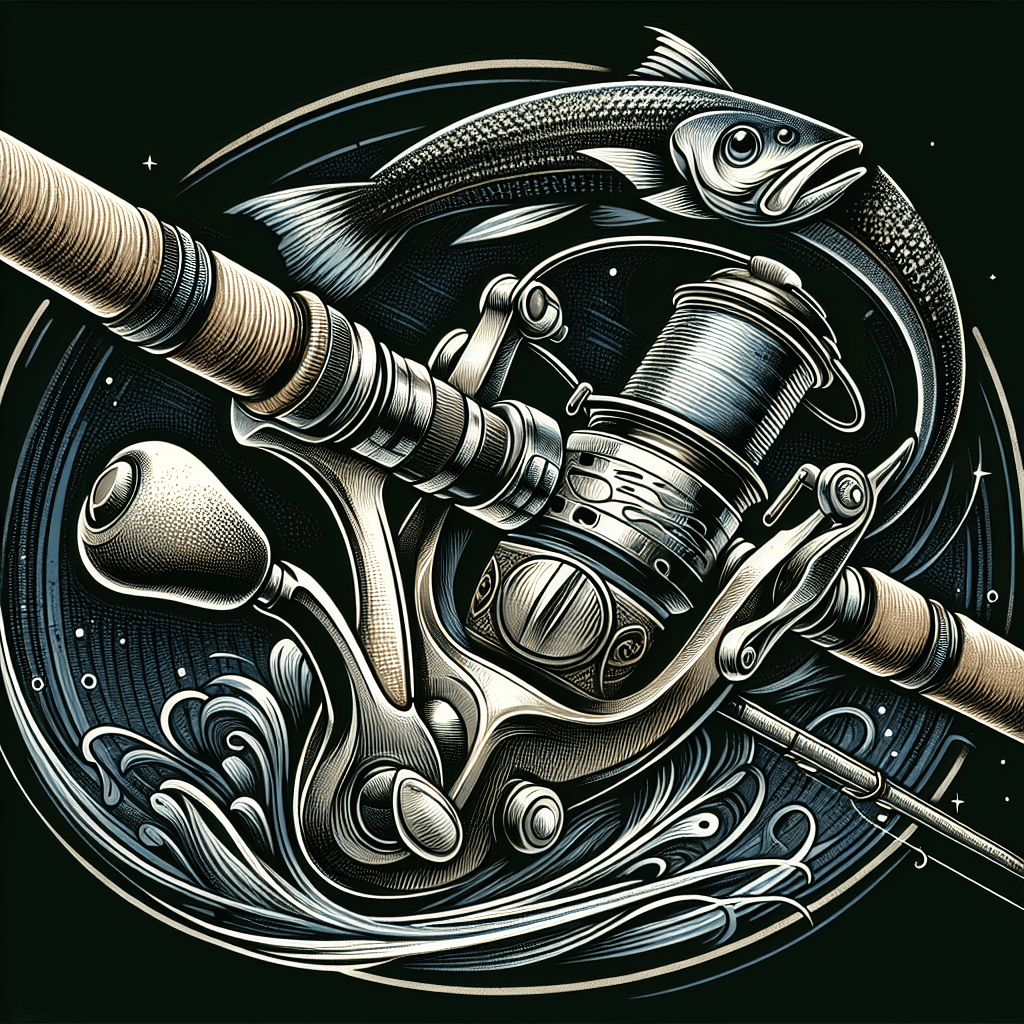If you’re an avid angler or just starting out, choosing the right fishing rod and reel combo can make all the difference in your fishing experience. With so many options available, it can be overwhelming to know where to begin. However, by considering your skill level and preferred type of fishing, you can easily narrow down the choices and find the perfect combination that suits your needs. Whether you enjoy freshwater or saltwater fishing, casting or trolling, this article will guide you through the process of selecting the ideal fishing rod and reel combo for you.

Determining your skill level
Evaluate your experience level
When choosing the right fishing rod and reel combo, it’s important to take into account your experience level as an angler. If you’re just starting out, you may want to opt for a beginner-friendly combo that is easy to handle and forgiving. These combos usually offer a good balance between affordability and functionality, allowing newcomers to get a feel for the sport without breaking the bank.
Consider your fishing techniques
Your fishing techniques also play a significant role in determining the type of fishing rod and reel combo that will suit you best. If you prefer casting with lures, you may want to go for a combo that provides a good casting distance and accuracy. On the other hand, if you’re more into bait fishing, a combo with a sensitive tip and a strong backbone for better hook sets would be a better fit.
Assess your casting ability
Another crucial factor to consider is your casting ability. If you’re still working on your casting skills, a combo with a forgiving action and a longer rod length can help you achieve better casts. However, if you’re confident in your casting abilities and are looking for more precision, a combo with a fast action and a shorter rod length might be the way to go.
Identifying your preferred type of fishing
Freshwater fishing
Freshwater fishing encompasses a wide range of angling experiences, including fishing in lakes, rivers, and ponds. If you enjoy pursuing species like bass, trout, pike, or panfish, freshwater fishing might be your preferred type of fishing. For this type of fishing, you’ll want to choose a combo that can handle lighter line weights and provides good sensitivity to detect subtle bites.
Saltwater fishing
Saltwater fishing is known for its thrill and the opportunity to target powerful and often larger species. Whether you’re fishing from a boat or casting from shore, you’ll need a combo specifically designed to withstand the harsh marine environment. Look for a saltwater-specific combo that offers corrosion-resistant materials, sturdy construction, and a strong drag system to handle the hard-fighting fish found in the ocean.
Fly fishing
For those who enjoy the art and precision of fly fishing, a specialized combo is necessary. Fly fishing requires a unique casting technique that relies on the weight of the line rather than the lure. When choosing a fly fishing combo, consider the weight of the rod, the type of reel, and the appropriate line weight for the species you’ll be targeting. Additionally, a combo with a slower action is recommended for beginners, while experienced fly anglers may prefer faster action rods for more control and distance.
Ice fishing
Ice fishing presents its own set of challenges and requires specialized equipment. When considering an ice fishing combo, look for a shorter rod length that allows for maneuverability in tight spaces. Ice fishing combos often come with small and lightweight reels designed to handle the specific demands of this unique fishing experience.
Surf fishing
Surf fishing involves casting from the shore along coastal beaches, often targeting species like striped bass, redfish, or sharks. As surf fishing requires long and precise casts, it’s essential to opt for a combo with a longer rod length and a reel with a high line capacity. Look for a combo that offers excellent casting distance, corrosion-resistant materials, and a powerful drag system to handle big fish in the surf.
Bass fishing
Bass fishing is one of the most popular types of fishing, and it requires a versatile combo that can handle various techniques. Whether you’re flipping and pitching in heavy cover or finesse fishing with light lures, a bass fishing combo should have a balance of sensitivity, power, and accuracy. Consider a medium to medium-heavy power rod with a fast or extra-fast action, paired with a reel with a smooth drag system and good casting performance.
Trout fishing
Trout fishing is characterized by its finesse and delicacy. When choosing a trout fishing combo, consider a lightweight rod with a sensitive tip to detect even the slightest nibbles. Look for a reel with a smooth drag system and a good line capacity to handle the occasional larger trout. The ideal choice may be a medium-light or light power rod with a moderate or fast action for better control during casts and fights.
Panfish fishing
Panfish, which include species like bluegill, crappie, and perch, are known for their abundance in freshwater bodies. For panfish fishing, a combo with a light or ultralight rod is recommended, as it provides sensitivity to detect bites and allows for better presentation of lighter lures. Look for a reel with a smooth drag system and a lightweight design to complement the finesse approach necessary for panfish angling.
Deep-sea fishing
Deep-sea fishing provides the opportunity to catch large and powerful species like tuna, marlin, or sailfish. For this type of fishing, you’ll need a heavy-duty combo that can handle the demanding conditions of offshore waters. Look for a combo with a heavy or extra-heavy rod, a durable reel with high line capacity, and a strong drag system capable of stopping hard-fighting fish.
Trolling
Trolling is a common technique used in both freshwater and saltwater fishing. If you enjoy trolling for species like walleye, salmon, or muskie, a trolling combo will suit your needs. Look for a combo with a medium-heavy to heavy power rod that can handle the strain of trolling. Additionally, choose a reel with a high line capacity and a good line retrieval rate to cover a larger area while trolling.
Choosing the right fishing rod
Understanding the rod types
Fishing rods come in various types, including spinning rods, casting rods, fly rods, and ice fishing rods. Each type is designed for a specific fishing technique and requires a corresponding reel. Consider the type of fishing you’ll be doing to determine which rod type is most suitable for your needs.
Considering the rod length
Rod length plays a crucial role in casting distance, control, and versatility. Longer rods typically offer better casting distance, while shorter rods provide more control and maneuverability in tight spaces. Consider the fishing environment and your preferred fishing techniques to determine the appropriate rod length for your needs.
Determining the rod power
Rod power refers to the amount of pressure needed to bend the rod and is typically categorized as ultra-light, light, medium-light, medium, medium-heavy, heavy, or extra-heavy. The power of the rod needs to match the size and weight of the fish you’ll be targeting. Lighter power rods are suitable for smaller species, while heavier power rods are designed to handle larger and more aggressive fish.
Deciding on the rod action
Rod action refers to how much the rod bends when pressure is applied to the tip. It is categorized as slow, moderate, moderate-fast, fast, or extra-fast. A slow action rod bends more throughout its length, while fast action rods bend mostly in the upper third or upper half. The choice of rod action depends on your fishing technique and the sensitivity you require.
Evaluating the rod materials
Rod materials can affect weight, sensitivity, and durability. Common materials include fiberglass, graphite, or a combination of both. Fiberglass rods are more durable and forgiving, making them suitable for beginners or anglers targeting larger fish. Graphite rods, on the other hand, offer greater sensitivity and flexibility, making them ideal for detecting subtle bites and fishing with lighter lures.
Checking the rod guides
Rod guides are the small rings attached to the rod that guide and protect the fishing line. High-quality rod guides are essential for smooth line flow during casting and retrieving. Look for guides made from durable materials, such as ceramics or stainless steel, which can resist wear and tear from fishing line friction.
Considering the rod handle
The rod handle plays a significant role in your comfort and control while fishing. Common handle materials include cork and EVA foam, each with their own pros and cons. Cork handles offer a traditional and comfortable grip, while EVA foam handles provide durability and better grip in wet conditions. Consider your fishing environment and personal preference when choosing a rod handle.
Considering the rod brand and warranty
When investing in a fishing rod, it’s worth considering reputable brands with a history of manufacturing high-quality rods. Established brands often have a wide range of options to choose from and offer warranties to protect your investment. Research customer reviews and seek recommendations from experienced anglers to ensure you’re purchasing a reliable and durable rod.
Selecting the appropriate fishing reel
Understanding the reel types
Fishing reels come in three main types: spinning reels, baitcasting reels, and fly reels. Each type is designed for different fishing techniques and requires a compatible rod. Consider your preferred fishing technique to determine which reel type is most suitable for your needs.
Matching the reel to the rod
When choosing a fishing reel, it’s essential to match it to the rod you’ll be using. Each reel and rod combination has specific specifications and limitations that should be considered. Ensuring compatibility between your rod and reel will optimize your fishing experience and help you achieve better performance.
Considering the reel size
Reel size is determined by the line capacity and the weight of the reel. Smaller reels are suitable for lighter lines and smaller fish, while larger reels are designed to handle heavier lines, larger fish, or situations where longer casts are required. Consider the target species and fishing techniques to determine the appropriate reel size for your needs.
Determining the reel gear ratio
The gear ratio of a fishing reel indicates how many times the spool turns for one complete turn of the handle. A higher gear ratio means faster line retrieval, while a lower gear ratio provides more torque for fighting larger fish. Consider your fishing technique and the speed at which you’ll need to retrieve your line when choosing a reel with the appropriate gear ratio.
Choosing the reel materials
Reel construction materials can affect weight, durability, and performance. Common reel materials include aluminum, graphite, and composite materials. Aluminum reels offer strength and durability but can be heavier. Graphite reels are lightweight and corrosion-resistant but may not be as sturdy. Composite reels combine the best characteristics of both materials. Consider your fishing environment and preferences when selecting the reel material.
Evaluating the reel drag system
The drag system of a fishing reel determines the amount of resistance applied to the line when a fish pulls. It is crucial for preventing the line from breaking during intense fights with powerful fish. Look for reels with smooth and reliable drag systems, as a quality drag system will allow you to land fish more efficiently and reduce the risk of losing them.
Checking the reel bearings
Reel bearings contribute to the smoothness and performance of a reel. More bearings generally result in smoother operation, but quality matters more than quantity. Look for reels with corrosion-resistant bearings made from materials like stainless steel or ceramic. High-quality bearings will provide better performance and durability over time.
Considering the reel brand and warranty
Similar to fishing rods, choosing a reel from a reputable brand can ensure reliability and durability. Reputable manufacturers often offer warranties to protect your investment. Research different brands, read customer reviews, and seek recommendations from experienced anglers to find a reliable reel that suits your needs.
Considering the combo options
Advantages of purchasing a combo
Buying a fishing rod and reel combo can offer several advantages. Combos are usually more cost-effective than purchasing a rod and reel separately, and they provide a balanced setup intended for specific fishing techniques. Additionally, purchasing a combo ensures that the rod and reel are compatible in terms of size, weight, and performance.
Types of fishing rod and reel combos
Fishing rod and reel combos come in various configurations to suit different fishing styles and skill levels. Spinning combos are popular and versatile, suitable for beginners and experienced anglers alike. Baitcasting combos offer greater accuracy and control for more advanced techniques. Fly fishing combos are specifically designed for the unique demands of fly angling.
Factors to consider when buying a combo
When purchasing a fishing rod and reel combo, there are several factors to consider. Assess your preferred fishing techniques, target species, and fishing environment to determine the appropriate combo type. Consider the rod and reel specifications, such as length, power, action, and gear ratio, to ensure they match your needs. Additionally, research the reputation and warranty of the combo to ensure you’re making a sound investment.
Testing the combo before buying
If possible, it’s always beneficial to test a fishing rod and reel combo before making a purchase. Visit local fishing stores or attend expos and events where you can handle and test different combos. Testing will give you a better feel for the combo’s weight, balance, sensitivity, and overall comfort. By trying out different combos, you can make an informed decision based on your personal preferences and fishing requirements.
Setting a budget
Determining your budget range
When choosing a fishing rod and reel combo, it’s important to establish a budget range that aligns with your financial capabilities. Decide how much you’re willing to invest in your gear while considering the frequency and intensity of your fishing activities. Setting a budget range will narrow down your options and prevent overspending.
Balancing quality and cost
While it may be tempting to opt for the cheapest combo available, it’s essential to strike a balance between quality and cost. High-quality combos often come with a higher price tag but offer better performance, durability, and overall satisfaction. Consider investing in a combo that meets your needs and provides good value for money.
Considering long-term investment
When setting your budget, consider the long-term value of the fishing rod and reel combo. A more expensive combo of superior quality may last longer and require less maintenance, saving you money in the long run. Analyze the cost-to-benefit ratio and prioritize durability and performance when making your final decision.
Seeking expert advice
Visiting local fishing stores
Local fishing stores can be a valuable resource for seeking expert advice. The staff at these stores often have extensive knowledge and experience in fishing, making them a reliable source of information. Consult with them about your skill level, preferred fishing type, and budget constraints. They can provide recommendations and guide you in choosing the right fishing rod and reel combo for your needs.
Consulting with experienced anglers
Experienced anglers are a treasure trove of knowledge when it comes to fishing gear. Reach out to fellow anglers who have experience in the type of fishing you’re interested in. They can offer insights, share their personal preferences, and provide recommendations based on their experiences. Their expertise can help you make an informed decision and avoid potential pitfalls.
Joining fishing communities and forums
Online fishing communities and forums are excellent platforms to connect with fellow anglers from around the world. Joining these communities allows you to ask questions, share experiences, and gain valuable advice. Engage in discussions specific to the fishing rod and reel combo you’re considering, and take note of recommendations and tips from seasoned anglers.
Reading online reviews and guides
Online reviews and guides can offer a wealth of information when it comes to fishing gear. Numerous websites and blogs provide comprehensive reviews, comparing different fishing rod and reel combos based on their performance, durability, and value for money. Reading these reviews can give you insights into the pros and cons of each combo, helping you make an informed decision.
Trying out different rods and reels
Participating in fishing rental programs
Some fishing rental programs allow you to try out different rods and reels before committing to a purchase. You can rent various combos and test them in real fishing scenarios, giving you a hands-on experience of how they perform. Take advantage of these programs to gain a better understanding of what features and specifications suit your fishing style.
Attending fishing expos and events
Fishing expos and events often provide opportunities for attendees to test and handle different fishing gear, including rods and reels. Take advantage of these events to try out various combos and interact with representatives from different brands. Attending these expos can be an enjoyable way to gather information and make a well-informed decision.
Borrowing from friends or family
If you have friends or family members who are avid anglers, consider borrowing their fishing gear to see what works best for you. Trying out different rods and reels on actual fishing trips can provide valuable insights into your personal preferences and help you determine the right combo for your needs.
Renting equipment from local tackle shops
Some tackle shops offer equipment rental services, allowing you to try out different fishing rods and reels for a specified period. Renting combos from these shops enables you to test multiple options and gain hands-on experience without making a permanent commitment. This approach can provide valuable information to help you make an educated decision.

Considering future skill progression
Anticipating skill improvement
As an angler, it’s essential to consider your skill progression and anticipate improvement over time. When choosing a fishing rod and reel combo, aim for equipment that will grow with you as your skills advance. Opt for combos that offer versatility, allowing you to explore different fishing techniques and tackle larger or more challenging species as you improve.
Choosing versatile equipment
Versatility is key when it comes to selecting a fishing rod and reel combo that will grow with your skills. Look for equipment that can handle a wide range of fishing techniques and adapt to different environments. A versatile combo will enable you to experiment with various techniques and fishing styles without needing to invest in additional gear.
Allowing room for upgrades
While it’s important to consider your current skill level, it’s also wise to leave room for future upgrades. As you progress as an angler, you may decide to specialize in a specific technique or target larger fish species. By choosing a combo that can be upgraded, you can gradually invest in higher-quality gear without having to replace your entire setup.
Maintaining and caring for your fishing gear
Properly cleaning your rod and reel
Regular cleaning is crucial for maintaining the performance and longevity of your fishing gear. After each fishing trip, rinse your rod and reel with fresh water to remove any salt or dirt. Use a mild soap and a soft cloth to clean the rod components and reel exterior. Avoid using harsh chemicals or abrasive materials that may damage the finish.
Storing your equipment correctly
Proper storage is essential for preserving the integrity of your fishing gear when not in use. Store your rod and reel in a cool, dry place away from direct sunlight and extreme temperatures. Avoid placing heavy objects on top of your rod to prevent bending or breakage. Consider using protective rod sleeves or tubes and reel covers to provide additional protection during storage and transportation.
Regularly inspecting and replacing worn parts
Perform routine inspections of your fishing gear to identify any signs of wear or damage. Check the rod guides for any cracks or wear, and replace them if necessary. Inspect the reel handle, drag system, and bearings for smooth operation, and lubricate them as recommended by the manufacturer. Replace any worn or damaged parts promptly to maintain optimal performance and prevent further damage.
By following these guidelines, you can ensure that your fishing rod and reel combo remains in excellent condition, providing you with years of enjoyable and successful fishing experiences. Remember to always prioritize safety, respect the environment, and adhere to local fishing regulations while pursuing your passion for angling. Happy fishing!


